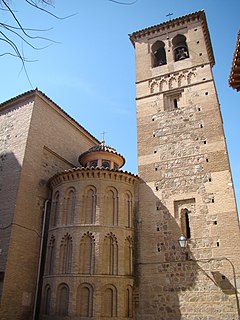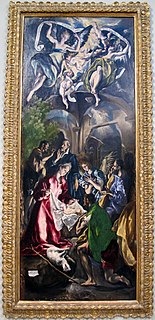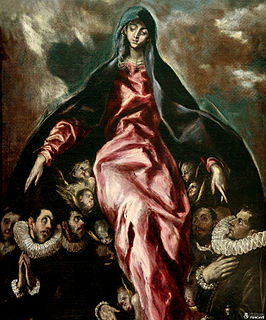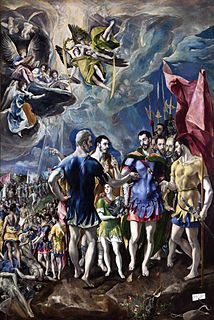Related Research Articles

Toledo is a city and municipality of Spain, capital of the province of Toledo and the de jure seat of the government and parliament of the autonomous community of Castilla–La Mancha. Toledo was declared a World Heritage Site by UNESCO in 1986 for its extensive monumental and cultural heritage.

Doménikos Theotokópoulos, most widely known as El Greco, was a Greek painter, sculptor and architect of the Spanish Renaissance. "El Greco" was a nickname, a reference to his Greek origin, and the artist normally signed his paintings with his full birth name in Greek letters, Δομήνικος Θεοτοκόπουλος, Doménikos Theotokópoulos, often adding the word Κρής Krēs, Cretan.

The Spanish Renaissance was a movement in Spain, emerging from the Italian Renaissance in Italy during the 14th century, that spread to Spain during the 15th and 16th centuries.
El Greco (1541–1614) was a prominent painter, sculptor and architect active during the Spanish Renaissance. He developed into an artist so unique that he belongs to no conventional school. His dramatic and expressionistic style was met with puzzlement by his contemporaries but gained newfound appreciation in the 20th century.

The Disrobing of Christ or El Expolio is a painting by El Greco begun in the summer of 1577 and completed in the spring of 1579 for the High Altar of the sacristy of the Cathedral of Toledo, where it still normally hangs. In late 2013 it was on temporary display at the Prado in Madrid, following a period of cleaning and conservation work there; it was returned to Toledo in 2014. It is one of El Greco's most famous works. A document dated July 2, 1577 which refers to this painting is the earliest record of El Greco's presence in Spain. The commission for the painting was secured thanks to El Greco's friendship from Rome with Luis, the son of Diego de Castilla, the dean of the Cathedral of Toledo. De Castilla senior also arranged El Greco's other major commission, on which he worked simultaneously, the paintings for the Toledan church of Santo Domingo el Antiguo.

Luis Tristán de Escamilla, also known as Luis de Escamilla or Luis Rodríguez Tristán, was a Spanish painter in the mannerist style.

Felipe Bigarny, also known as Felipe Vigarny, Felipe Biguerny or Felipe de Borgoña, etc. and sometimes referred to as El Borgoñón, was a sculptor born in Burgundy (France) but who made his career in Spain and was one of the leading sculptors of the Spanish Renaissance. He was also an architect.

The Monastery of Saint Dominic of Silos is a Cistercian convent in Toledo, Spain.

Saint Peter and Saint Paul is a painting by the Cretan-Spanish artist El Greco. The work was completed between 1590 and 1600. It is currently on display at the Museu Nacional d'Art de Catalunya, who purchased the work in 1932.

Jorge Manuel Theotocópuli was a Spanish painter and architect. He was the only son of the iconic painter, Doménikos Theotokópoulos, called "El Greco".

The El Greco Museum is located in Toledo, Spain. It celebrates the mannerist painter El Greco, who spent much of his life in Toledo, having been born in Fodele, Crete.

View and Plan of Toledo is a landscape painting by El Greco. The image is notable for its juxtaposition of the view of Toledo with the trompe l'oeil map of the city's streets. In the composition, El Greco also included an allegory of the Tagus River, a scene of the Virgin Mary placing a chasuble on Saint Ildefonsus, and an elevation of the Tavera Hospital floating on a cloud. It was probably originally commissioned by Pedro Salazar de Mendoza and is currently preserved in the El Greco Museum in Toledo, Spain.

Saint Sebastian, or Martyrdom of Saint Sebastian is an autograph work by the famed artist Doménikos Theotokópoulos, commonly known as El Greco. It shows the Martyred Saint in an atypical kneeling posture which has led some scholars to believe it to be a compositional quotation of various works by other great masters whom the artist admired. The painting is currently on display in the Palencia Cathedral.

Saint Louis is a 1592–1595 painting by El Greco, painted during his time in Toledo. It is now in the Louvre in Paris.

The Adoration of the Shepherds is a painting of the traditional subject which was painted by El Greco in 1596. It is in the European painting collection of the National Museum of Art of Romania. This unusually tall painting is a work in the group of equally tall paintings which the artist made as part of his 1596 commission known as the Doña María de Aragón Altarpiece for the Colegio de Dona Maria de Aragón in a building that is now the location of Palacio del Senado in Madrid. El Greco's signature, in Greek, may be seen on the paper in the lower left corner.

The Santo Domingo el Antiguo Altarpiece is a 1577-1579 altarpiece by El Greco, painted for the Monastery of Santo Domingo el Antiguo in Toledo, Spain. The artist had just arrived in Spain and this was his first major commission there, gained thanks to Diego de Castilla, who he had met in Rome.

Portrait of Fernando Niño de Guevara is a 1600 painting of cardinal Fernando Niño de Guevara by El Greco, now in the Metropolitan Museum of Art in New York.

The Virgin of Charity is a 1597-1603 painting by El Greco. It was part of a commission to paint five works for the high altarpiece of the Santuario de Nuestra Señora de la Caridad in the Spanish town of Illescas, Toledo, gained through the mediation of his son Jorge Manuel Theotocópuli. It still hangs in the Santuario. Three of the other works still hang in the church, whilst the fifth is in the National Museum of Art of Romania.

The Virgin of the Immaculate Conception is a painting of the Immaculate Conception by El Greco. The work on the painting began in 1607 and was completed in 1613. It is owned by the church of San Nicolás de Bari in Toledo, Spain. It is displayed, however, in the El Greco Museum, Toledo.

The Martyrdom of Saint Maurice is a 1580-1582 painting by El Greco in the Real Monasterio de San Lorenzo de El Escorial near Madrid.
References
- 1 2 M. Irving, How to beat the Spanish Inquisition
- ↑
- "High Altar". Web Gallery of Art. Retrieved 2006-12-18.
| | This article about a Catholic clergyman is a stub. You can help Wikipedia by expanding it. |